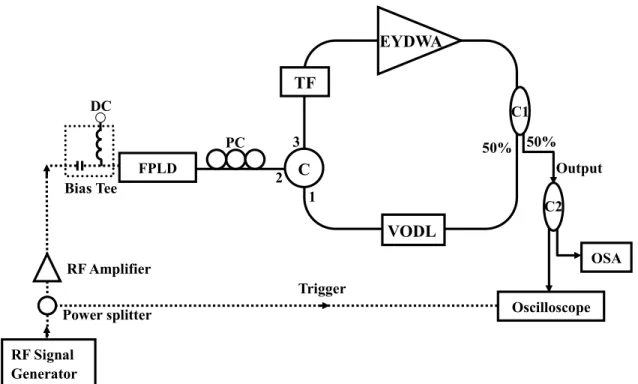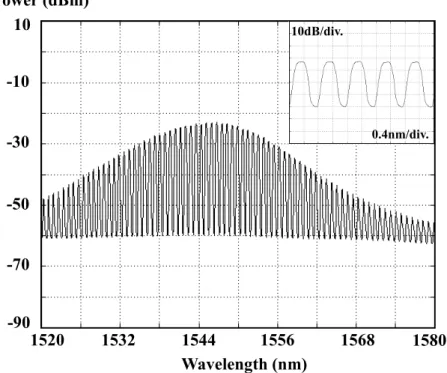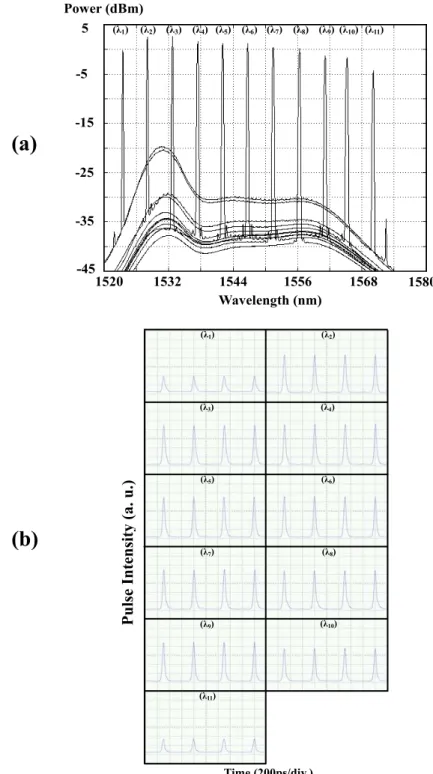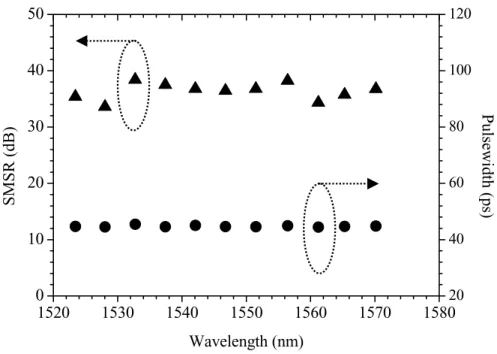Widely wavelength-tunable pulse generation from an actively
mode-locked fiber laser with a Fabry-Perot laser diode
Peng-Chun Peng
a, Jia-He Lin
a, and Sien Chi
a,b aInstitute of Electro-Optical Engineering, National Chiao-Tung University, Hsinchu, Taiwan 300,
R.O.C.
b
Department of Electrical Engineering, Yuan Ze University, Chungli, Taiwan 320, R.O.C.
ABSTRACT
An actively mode-locked fiber ring laser for generating wavelength-tunable optical pulses is demonstrated. An Er-Yb doped waveguide amplifier is used as an optical amplifier, and a Fabry-Perot laser diode is used as a modulator in the fiber laser. Moreover, we add a variable optical delay line to control the cavity length for maintaining a constant repetition frequency and pulsewidth at different wavelengths. The optical side-mode-suppression-ratio is better than 33.5 dB over the wavelength-tunable range of 46 nm.
Keywords: Fiber laser, tunable laser, mode-locked fiber laser, Fabry-Perot laser diode, Er-Yb doped waveguide amplifier
1. INTRODUCTION
Actively mode-locked fiber ring lasers are attractive optical sources to generate wavelength-tunable pulses for the applications in wavelength-division-multiplexing optical communication systems, high speed optical switching systems, and optical fiber sensing systems. Generally, Fiber lasers are actively mode-locked by a Mach-Zehnder modulator or an electro-absorption modulator [1-2]. Recently, fiber ring lasers for generating wavelength-tunable pulses by using a low-cost Fabry-Perot laser diode (FPLD) as both a modulator and a tunable filter was presented. The tuning range was up to 4.8 nm [3-5]. Another scheme also has been proposed by using an FPLD as a modulator and a high birefringence fiber loop mirror as filter. The wavelength-tunable range was about 10 nm with pulsewidth between 60 ps and 70 ps [6]. Furthermore, we also proposed a wavelength-tunable mode-locked linear-cavity fiber laser using an FPLD as a modulator. The side-mode-suppression-ratio (SMSR) was over 30 dB, and the wavelength-tunable range was about 27 nm. This fiber laser generated pulses with pulsewidth between 53 ps and 80 ps at a repetition frequency of 908.39 MHz [7].
Because the repetition frequency is determined by the cavity length of fiber laser, this mode-locked scheme is difficult to have widely wavelength-tunable range and a constant repetition frequency and pulsewidth at different wavelengths. In this paper, we present a configuration to generate wavelength-tunable optical pulses by an actively mode-locked fiber ring laser with an FPLD. The operating wavelength is selected by a tunable filter, and its intensity is enhanced by an Er-Yb doped waveguide amplifier (EYDWA) [8-10]. Moreover, we add a variable optical delay line (VODL) in the fiber laser to control the cavity length so that the wavelength-tunable range and repetition frequency will not be limited by a fixed cavity length. Therefore, this fiber laser can have widely wavelength-tunable range and maintain a constant repetition frequency and pulsewidth at different wavelengths. The performance of this fiber laser operated at the different wavelengths is reported.
Output 50% 50% OSA Oscilloscope Trigger RF Amplifier Power splitter RF Signal Generator C2 FPLD PC 1 2 3 DC Bias Tee
TF
EYDWA
VODL
C
C1Figure 1. Experimental setup of the wavelength-tunable mode-locked fiber ring laser. (FPLD: Fabry-Perot laser diode, PC:
Polarization controller, EYDWA: Er-Yb doped waveguide amplifier, TF: fiber Fabry-Perot tunable filter, VODL: variable optical delay line, C1: 1x2 coupler with coupling ratio 50:50, C2: 1x2 coupler with coupling ratio 50:50, OSA: optical spectrum analyzer).
2. EXPERIMENT AND RESULTS
Figure 1 shows the proposed configuration of the actively mode-locked fiber ring laser. In our experiment, the fiber ring laser consisted of an EYDWA, an FPLD, a tunable filter (TF), a VODL, an optical circulator (C), a polarization controller (PC), and a 1x2 coupler (C1) with coupling ratio 50:50. Figure 2 shows the schematic diagram of the EYDWA. The EYDWA with a saturated output power 12 dBm is manufactured by Teem Photonics via a two step ion exchanges process [9]. The tunable filter is a fiber Fabry-Perot tunable filter. The insertion loss of tunable filter is 1.9 dB. The free spectral range (FSR) and 3 dB bandwidth of tunable filter are 48.7 nm and 0.53 nm, respectively. The FPLD used is a commercial 1550 nm device with a threshold current of 18 mA at 25 oC and a mode spacing of 0.8 nm. Furthermore, it
does not have antireflection coating. The radio frequency (RF) sinusoidal signal is used to drive the FPLD into gain-switching operation via a bias-tee circuit. The polarization controller is used to optimize the output SMSR because only one polarization direction of the feedback light results in the maximum efficiency of FPLD. The manual VODL (from General Photonics Corp.) is used to control the round trip pulse propagation time. The insertion loss of VODL is 1.2 dB.
HI
Er-Yb waveguide
980nm pump Pump filter WDM
Isolator Isolator
EYDWA
Input
Output
Figure 2. Schematic diagram of the EYDWA (WDM: 980/1550nm WDM coupler).
1580
1568
1556
1544
1532
1520
Wavelength (nm)
10dB/div. 0.4nm/div.10
-50
Power (dBm)
-90
-30
-70
-10
IL :\
\ RI .
kit
1kH
J.7;
Pulse
Intensit
y(
a. u.
)
Time (200ps/div.) (Ȝ1) (Ȝ10) (Ȝ3) (Ȝ4) (Ȝ5) (Ȝ6) (Ȝ7) (Ȝ8) (Ȝ9) (Ȝ2) (Ȝ11)Figure 4 (a) Output spectra and (b) pulse waveforms of the fiber ring laser when the central wavelength of the tunable filter coincides
with one of the wavelength of the FPLD lasing modes.
(a)
(b)
5 -25 Power (dBm) -45 1520 1580 Wavelength (nm) -15 -35 1532 1568 1544 1556 -5 (Ȝ1) (Ȝ2) (Ȝ3) (Ȝ4) (Ȝ5) (Ȝ6) (Ȝ7) (Ȝ8) (Ȝ9)(Ȝ10) (Ȝ11)1520
1530
1540
1550
1560
1570
1580
0
10
20
30
40
50
Wavelength (nm)
SM
SR (
d
B)
20
40
60
80
100
120
Pulsew
idth (ps)
For the simultaneous spectrum and waveform measurement, the output laser is split by a 1x2 coupler (C2) with coupling ratio 50:50 and measured by an optical spectrum analyzer (OSA) and a sampling oscilloscope with optical input port (86100A from Agilent Technologies). The FPLD is biased slightly below the threshold 2.4 mA and gain-switched at 2000 MHz. Figure 3 shows the output spectrum of the gain-switched FPLD. The tunable filter is used to select the lasing wavelength. When the central wavelength of tunable filter is close to the one of wavelengths of the FPLD lasing modes, the output of FPLD is limited to this specific wavelength. Thus this fiber laser only performed on single wavelength operation. In our experiment, the optimum cavity length is selected that the fiber laser can generate the best SMSR by adjusting the VODL. Figure 4 shows the output spectra and pulse waveforms when the central wavelength of the tunable filter coincides with one of the wavelengths of the FPLD lasing modes. The background of output spectra reflects the amplified spontaneous emission of the EYDWA. Because the FSR of tunable filter is 48.7 nm, the small peak is observed when tunable filter is tuned to 1523.42 nm and 1570.16 nm. The intensities are not uniform due to cavity loss at different wavelengths and the gain profile of FPLD and EYDWA. Furthermore, different injection power and wavelength to FPLD will generate different pulsewidth. In order to maintain the pulsewidth, we need slightly adjust the VODL at different wavelengths. The tunable range of this fiber laser is over 46 nm (from 1523.42 nm to 1570.16 nm). The SMSR and the pulsewidth as a function of wavelengths are shown in Figure 5. The pulsewidth maintain around 45 ps at a repetition frequency of 2000 MHz. Overall, the proposed mode-locked fiber laser using a commercial FPLD as modulator is simple and cost effective. Such a fiber laser represents an economical alternative for the generation of widely wavelength-tunable optical short pulses.
3. CONCLUSION
In this paper, we have demonstrated an actively mode-locked fiber laser with an FPLD to generate wavelength-tunable optical pulses. The wavelength tunable is achieved by the tunable filter, and the EYDWA is used as an optical amplifier in the fiber laser. In order to maintain a constant repetition frequency and pulsewidth at different wavelengths, the variable optical delay line is used to control the cavity length. The wavelength-tunable range of fiber laser is over 46 nm with SMSR up to 33.5 dB. Furthermore, the pulsewidth maintain around 45 ps at a constant repetition frequency of 2000 MHz.
ACKNOWLEDGMENTS
This work was supported in part by the MediaTek Fellowship and the National Science Council of R. O. C. under contract NSC 93-2752-E-009-009-PAE and NSC 93-2215-E-155-005.
REFERENCES
1. J. S. Wey, J. Goldhar, and G. L.Burdge, “Active harmonic mode-locking of an erbium fiber laser with intracavity Fabry-Perot filters,” J. of Lightwave Technology, vol. 15, pp. 1171-1180, 1997.
2. M. J. Guy, J. R. Taylor, and K. Wakita, “10 GHz 1.9 ps actively mode-locked fiber integrated ring laser at 1.3 µm,” Electronics Letters, vol. 33, no. 19, pp. 1630-1632, 1997.
3. S. Li and K. T. Chan, "Actively mode-locked erbium fiber ring laser using a Fabry-Perot semiconductor modulator as mode locker and tunable filter," Applied Physics Letters, vol. 74, pp. 2737-2739, 1999.
4. S. Li and K. T. Chan, “Wavelength-tunable actively mode-locked erbium-doped fiber ring laser using a distributed feedback semiconductor laser as mode locker and tunable filter,” Applied Physics Letters, vol. 75, pp. 313-315, 1999.
5. D. Zhao, K. T. Chan, Y. Liu, L. Zhang, and I. Bennion, "Wavelength-switched optical pulse generation in a fiber ring laser with a Fabry-Perot semiconductor modulator and a sampled fiber Bragg grating," IEEE Photonics
Technology Letters, vol. 13, pp. 191 -193, 2001.
6. S. Yang, Z. Li, X. Dong, S. Yuan, G. Kai, and Q. Zhao, "Generation of wavelength-switched optical pulse from a fiber ring laser with an F-P semiconductor modulator and a HiBi fiber loop mirror," IEEE Photonics Technology
Letters, vol. 14, pp. 774 -776, 2002.
7. P. C. Peng, J. H. Lin, and S. Chi, “Generation of wavelength-tunable optical pulses using a linear-cavity fiber laser scheme with a Fabry-Perot laser diode,” IEEE Photonics Technology Letters, vol. 16, pp. 1023-1025, 2004. 8. Y. Jaouen, L. du Mouza, D. Barbier, J. M. Delavaux, and P. Bruno, “Eight-wavelength Er-Yb doped amplifier:
combiner/splitter planar integrated module,” IEEE Photonics Technology Letters, vol. 11, pp. 1105-1107, 1999. 9. C. M. McIntosh, J. M. P. Delavaux, G. C. Wilson, C. Hullin, B. Neyret, J. Philipsen, C. Cassagnettes, and D.
Barbier, “High output power erbium doped waveguide amplifier for QAM distribution,” Optical fiber
communication conference 2001 (OFC’2001), vol. 3, pp. WDD5-1 -WDD5-3, 2001.
10. K. C. Reichmann, P. P. Iannone, M. Birk, N. J. Frigo, D. Barbier, C. Cassagnettes, T. Garret, A. Verlucco, S. Perrier, and J. Philipsen, “An eight-wavelength 160-km transparent metro WDM ring network featuring cascaded erbium-doped waveguide amplifiers” IEEE Photonics Technology Letters, vol. 13, pp. 1130-1132, 2001.



